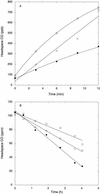Soil-atmosphere CO exchanges and microbial biogeochemistry of CO transformations in a Brazilian agricultural ecosystem
- PMID: 12200303
- PMCID: PMC124099
- DOI: 10.1128/AEM.68.9.4480-4485.2002
Soil-atmosphere CO exchanges and microbial biogeochemistry of CO transformations in a Brazilian agricultural ecosystem
Abstract
Although anthropogenic land use has major impacts on the exchange of soil and atmosphere gas in general, relatively little is known about its impacts on carbon monoxide. We compared soil-atmosphere CO exchanges as a function of land use, crop type, and tillage treatment on an experimental farm in Parãna, Brazil, that is representative of regionally important agricultural ecosystems. Our results showed that cultivated soils consumed CO at rates between 3 and 6 mg of CO m(-2) day(-1), with no statistically significant effect of tillage method or crop. However, CO exchange for a pasture soil was near zero, and an unmanaged woodlot emitted CO at a rate of 9 mg of CO m(-2) day(-1). Neither nitrite, aluminum sulfate, nor methyl fluoride additions affected CO consumption by tilled or untilled soils from soybean plots, indicating that CO oxidation did not depend on ammonia oxidizers and that CO oxidation patterns differed in part from patterns reported for forest soils. The apparent K(m) for CO uptake, 5 to 11 ppm, was similar to values reported for temperate forest soils; V(max) values, approximately 1 micro g of CO g (dry weight)(-1) h(-1), were comparable for woodlot and cultivated soils in spite of the fact that the latter consumed CO under ambient conditions. Short-term (24-h) exposure to elevated levels of CO (10% CO) partially inhibited uptake at lower concentrations (i.e., 100 ppm), suggesting that the sensitivity to CO of microbial populations that are active in situ differs from that of known carboxydotrophs. Soil-free soybean and corn roots consumed CO when they were incubated with 100-ppm concentrations and produced CO when they were incubated with ambient concentrations. These results document for the first time a role for cultivated plant roots in the dynamics of CO in an agricultural ecosystem.
Figures




References
-
- Bartholomew, G. W., and M. Alexander. 1982. Microorganisms responsible for the oxidation of carbon monoxide in soil. Environ. Sci. Technol. 16:300-301. - PubMed
-
- Bender, M., and R. Conrad. 1994. Microbial oxidation of methane, ammonium and carbon monoxide, and turnover of nitrous oxide and nitric oxide in soils. Biogeochemistry 27:97-112.
-
- Castro, M. S., W. T. Peterjohn, J. M. Mellilo, P. A. Steudler, H. L. Gholz, and D. Lewis. 1994. Effects of nitrogen fertilization on the fluxes of N2O, CH4, and CO2 from soils in a Florida slash pine plantation. Can. J. For. Res. 24:9-13.
Publication types
MeSH terms
Substances
LinkOut - more resources
Full Text Sources

